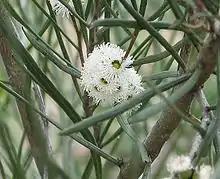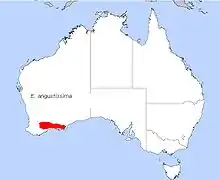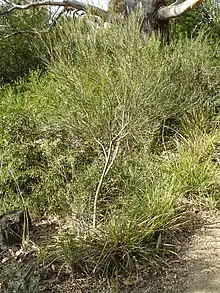Eucalyptus angustissima
Eucalyptus angustissima, or narrow-leaved mallee, is a small tree that is native to the south of Western Australia. Distribution is scattered in southern coastal and subcoastal areas. The tree is endemic to Western Australia.
| Narrow-leaved mallee | |
|---|---|
 | |
| Scientific classification | |
| Kingdom: | Plantae |
| Clade: | Tracheophytes |
| Clade: | Angiosperms |
| Clade: | Eudicots |
| Clade: | Rosids |
| Order: | Myrtales |
| Family: | Myrtaceae |
| Genus: | Eucalyptus |
| Species: | E. angustissima |
| Binomial name | |
| Eucalyptus angustissima | |
 | |
| E. angustissima, field distribution | |

Description
It is a mallee eucalyptus that grows from about 1 to 4 metres in height. The bark is smooth or matt, mottled grey and very white/grey or light grey-brown. Its juvenile leaves are 4.5 to 8 cm long and 0.3 to 0.4 cm wide The adult leaves are 7 to 11.5 cm long and very narrow (0.15 to 0.3 cm wide). The buds occur in clusters of up to 7 and are followed by creamy-white flowers that appear between August and January[2] and hemispherical fruits 0.5 to 0.8 cm wide. The crown is often very dense and not immediately recognisable as a eucalypt.[3]
There are two recognised subspecies:
Taxonomy
First described by the botanist Ferdinand von Mueller in his series of papers Fragmenta phytographiae Australiae in 1863 from samples collected by George Maxwell near Point Maxwell.[6] E. angustissima subsp. quaerenda was described in the journal Telopea in 1992 by L.A.S.Johnson and K.D.Hill from samples collected by Johnson and Maxwell from near Lake Chinocup.[5]
Distribution
The species is often on saline flats or around saltpans or on sandhills. It will grow in white or grey sands, clay, loam, sometimes saline soils in scrubland or woodland areas.[2]
See also
References
- Fensham, R.; Laffineur, B.; Collingwood, T. (2019). "Eucalyptus angustissima". IUCN Red List of Threatened Species. 2019: e.T133374756A133374758. doi:10.2305/IUCN.UK.2019-3.RLTS.T133374756A133374758.en. Retrieved 19 November 2021.
- "Eucalyptus angustissima". FloraBase. Western Australian Government Department of Biodiversity, Conservation and Attractions.
- Brooker, I., Kleinig, D. Eucalypts, A guide to identification, Reed, Melbourne, 1996
- "Eucalyptus angustissima F.Muell. Fragm. 4: 25 (1863) subsp. angustissima". Euclid. CSIRO. 2002. Retrieved 29 October 2016.
- "Eucalyptus angustissima subsp. quaerenda L.A.S.Johnson & K.D.Hill, Telopea 4: 598 (1992)". Euclid. CSIRO. 2002. Retrieved 29 October 2016.
- "Eucalyptus angustissima F. Muell., Fragm. 4: 25 (1863)". Eucalink. Royal Botanic Garden, Sydney. Retrieved 29 October 2016.
